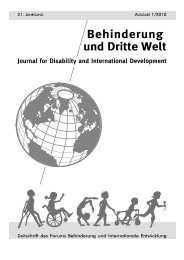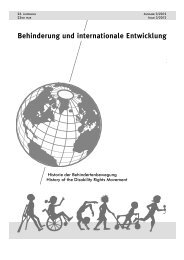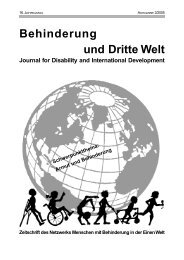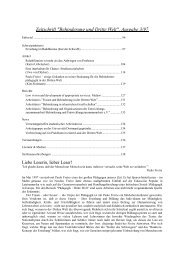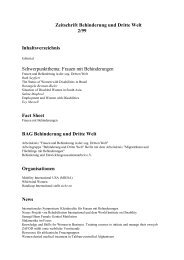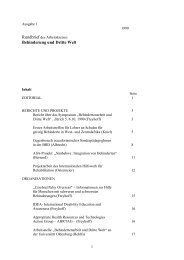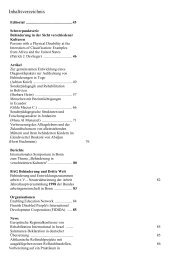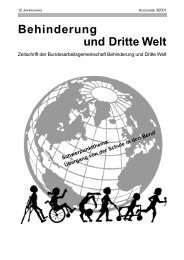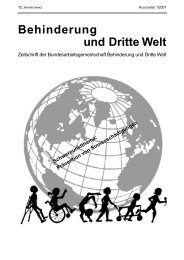S CHWERPUNKTTHEMAThe Potential and Promise of the CRPD on the Role ofWomen with Disabilities in the Global Move towardsRecognition and InclusionCharlotte McClain-Nhlapo & Laura McDonaldResearch on the experience of women and girls with disabilities is limited, particularly in resource-poor settings.Existing studies to date highlight that girls and women with disabilities are often vulnerable to discrimination, exclusionand violence. Such exclusion is often caused by societal stigmatization linked to their status in society as itrelates to their disability and gender. This double form of discrimination is furthered by limited research and continuedsocio-economic exclusion. Together, their marginalization within the larger community and society, resultsin their limited access to key activities, critical for health, empowerment, development and well-being, includingfor example, access to education, health services and employment. In this article, in addition to providing informationon the marginalization of girls and women with disabilities, the authors <strong>und</strong>erscore the potential of the Conventionon the Rights of Persons with Disabilities (CRPD) to respond effectively. The CRPD, widely ratified by morethan 71 countries worldwide, has the potential to lead to concrete actions which can play an important role in ensuringthat the rights of girls and women with disabilities are respected, promoted, and protected. The authorsalso provide recommendations for priority action.The Convention on the Rights of Persons withDisabilities (CRPD) which entered into force inMay 2008 codifies, for the first time, the legalobligation and commitment of its states partiesto protecting, promoting and ensure the humanrights of people with disabilities. To date, theCRPD has been ratified by more than 66 countriesworldwide 1 . This legally binding instrumentwill have an impact, in particular, on thelives of women and girls with disabilitiesthroughout the world – who continue to facedouble discrimination as a result of both theirdisability and gender status (Groce 1997). TheCRPD’s specific and concrete provisions addressthe lived experience of women and girls withdisabilities of dual-faceted discrimination whichoperates at both the policy- and communitylevels.Despite the numbers of women and girlswith disabilities worldwide, there is scarce researchto date on their needs compared toother vulnerable groups. And, in particular,there is scant information on the intersectionbetween gender and disability. This is, in part, aresult of limited research on disability in resource-poorsettings (McDonald & Rockhold unpublished).Not a priority to date in the internationalresearch and/or development agenda.One study, to date which attempts to uncoverthe lived experience of people with disabilities 2and, in particular, that of women and girls withdisabilities.International development and humanitarianaid literature, however, in recent years has increasinglyemphasized that people with disabilities,particular women and girls with a disability,are vulnerable to discrimination, exclusionand violence. In terms of women with disabilities,research has fo<strong>und</strong> that women withdisabilities are often a highly marginalizedgroup. In many settings, they are disproportionatelypoor, illiterate, socially isolated and <strong>und</strong>erserved,with reduced if any access to publicservices (Hershey 2000). The literacy rate ofpeople with disabilities worldwide highlights thelevel of exclusion experienced by people withdisabilities – reaching as low as 3%. It further<strong>und</strong>erscores the disparity in terms of genderwhere among women with disabilities the literacyrate is even much smaller at an estimated1%. (UNDP 1998).Within the literature, and in emerging discussionand research, various issues which profo<strong>und</strong>lyaffect the lives of women with disabilitieswhich require action and attention. Theseinclude: sexual and reproductive health, livelihoodactivities, as well as violence, abuse andexploitation. (Brownridge 2006; Becker et al.1997; Hassouneh-Phillips & Curry 2002). Thecentrality of these issues was recently highlightedin the context of a World Bank/GlobalPartnership for Disability & Development(GPDD) led E-Discussion on Women with Disabilitiesin Development which took place fortwo weeks in March 2009 (see summary in thisIssue and the World Bank Disability & Developmentwebsite 3 ).Despite the noted limitation in research, ex-34 <strong>Zeitschrift</strong> <strong>Behinderung</strong> <strong>und</strong> <strong>Dritte</strong> <strong>Welt</strong> 3/2009
S CHWERPUNKTTHEMAisting studies within these areas provide seriouscause for concern. Within many societies worldwide,severe exclusion of girls with disabilitiesbegins at a very young age where they areneedlessly prevented from engaging in basicactivities essential for their development. Forexample, girls with disabilities are not able toaccess schooling. While less than 5 % of childrenwith disabilities access education andtraining according to the UN Secretary General’sReport on the Implementation of theWorld Programme of Action Concerning Disabled,the percentage among girls alone maybe much lower (Rousso 2006). One-third ofout-of-school children in developing countrieshave a disability (Peters 2003). Disability is astronger correlate of non-enrolment than eithergender or class (Filmer 2008).In many contexts, a disabled child is consideredeither a curse or of little use to a family (interms of their livelihood, ability to marry andprocreate, etc.). Further, societal favoritism ofmales can increase the likelihood that girls willexperience slowed development and disability –and exacerbate any existing conditions. For example,in societies which favor boys, familieswith scarce resources might expend greater attentionin meeting the needs of boys which canresult in poorer nutrition and/or reduced healthcare among girls, likely to hamper healthy developmentand to increase the possibility of disabilityand exacerbate any existing disabilitiesor lead to secondary disabilities.The systemic exclusion girls experience islikely to have a negative impact on their selfesteemand perceived value and worth in theirsociety – more specifically, their perceived potentialto participate in society as productivemembers – as workers, as wives, and/or asmothers. These girls – as they become womencontinue to face significant socio-economic exclusionwhich is often thought to signify their“dependency, loss of status and relegation toan unproductive, asexual role in community”(Morris 1991). Such views even further theirisolation. While views that women cannot beadequate mothers and wives are held moretightly among some societies than others, eventhe most modern societies – do not believe inand/or assume women with disabilities are capableof such roles (see Malacrida 2009). A recentWorld Bank study, for example, in Indiafo<strong>und</strong> that women with disabilities were lesslikely to be married than their non-disabledpeers (World Bank 2007).Research in various settings worldwide hasfo<strong>und</strong> that adults with disabilities have highrates of unemployment compared to their nondisabledcounterparts. This is true in both developingand industrialized countries (Eide &Loeb 2006; McDonald & Rockhold, <strong>und</strong>ated; Elwan1999; U.S. Department of Labor 2008).Further, it has been fo<strong>und</strong> that women with disabilitiesare affected far worse than their malecounterparts in terms of accessing employmentwhereby “men with disabilities are almost twiceas likely to have jobs than [sic] women with disabilities.”(O’Reilly 2003) Moreover, the experienceof women with disabilities who are in employmentis extremely sub-standard: “Whenwomen with disabilities work, they often experienceunequal hiring and promotion standards,unequal access to training and retraining, unequalaccess to credit and other productive resources,unequal pay for equal work and occupationalsegregation, and they rarely participatein economic-decision making” (Ibid).In the context of severe stigmatization andsocio-economic exclusion across the lifespan,violence is likely to occur and further render awoman with disabilities – precisely because ofher exclusion and required dependence on others– incapable of escaping. Their exclusion, relianceon others for socio-economic well-beingand physical support – combined with limitedaccessibility and accommodation of basic needsby assistance programs, women with disabilitieshave few options for escaping or resolving theabuse.Violence, abuse and exploitation are often acomponent of the lived experience of womenwith disabilities. According to a recent nationalstudy in the U.S. of nearly 1,000 women, 62%of both women with and without disabilitieshad experienced emotional, physical, or sexualabuse over their lifetime. It was also fo<strong>und</strong>,however, that women with disabilities experiencedviolence for longer periods of time andwere victimized by a wider variety of perpetrators(i.e., attendants, adult child caregivers,spouses, etc.) than non-disabled women. Ofthe women with disabilities, 13% described experiencingphysical or sexual abuse in the previousyear. (Baylor College of Medicine, <strong>und</strong>ated)This rate is significantly higher than therate of violence reported by their non-disabledcounterparts. Such a high incidence of violenceexperienced by women with disabilities hasbeen fo<strong>und</strong> in numerous settings worldwide(Sullivan & Knutson 2000; Hassouneh-Phillips2005; Octay & Tompkins 2004; Kvam &Braathen 2006; Saxton 2009).Research on such areas, as those highlightedabove, can play a critical role in informing policy-making,determining priorities and guidingaction and response of assistance organiza-<strong>Zeitschrift</strong> <strong>Behinderung</strong> <strong>und</strong> <strong>Dritte</strong> <strong>Welt</strong> 3/200935



